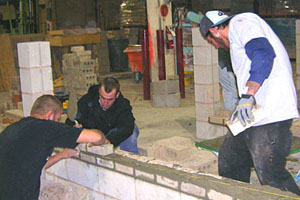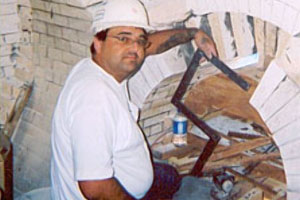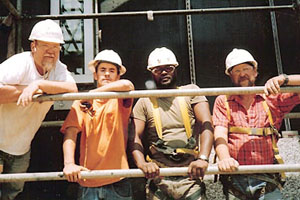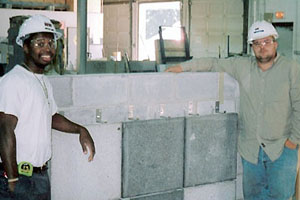Labor Crunch
By Brett Martin

One of the most pressing issues facing the masonry industry is attracting skilled workers. Industry analysts say that a growing industry coupled with the retirement of experienced masons has created a demand for new hires.
The U.S. Department of Labor projects the construction industry to be among the top 10 largest sources of employment growth through 2012, hiring approximately 240,000 workers each year — many of them for masonry.
Those statistics aren't a surprise to Patrick McLaughlin, executive director for the Florida Masonry Apprentice and Educational Foundation Inc. in Boca Raton. Fla. "We're always having a problem finding qualified people in the masonry industry," he said.
Amy Vasquez, executive director for the Masonry Industry Training Association (MITA) in Southern California, agreed. "There is a lack of qualified labor. Right now, the average age of a journeyman is 52 years old and the average age of an apprentice is 28," she said. "We're trying to replace the old with the new."
"We have had trouble hiring. In the Washington [state] area, it's been a problem for a while," said Monty Fairweather, president of Fairweather Masonry Company Inc., a 100-employee firm in Bellevue, Wash., that starts masons out at union scale. "We are competing with the other trades."
The recent economic slowdown has helped slightly since more people are now looking for work, said Scott Griffin, president of Griffin Masonry Inc., a Charlotte, N.C.-based company with 70 crews and more than 400 employees. "That's not going to be a long-term solution," Griffin pointed out. "I think finding qualified workers is one of our biggest challenges as a company and as an industry."
In fact, the need for workers has sometimes forced Griffin to hire employees at a higher-than-average starting pay rate.
"There are situations where we have paid people more than they were valued at, but we hoped for long-term employment that would make that investment reap a benefit two to three years down the road," he said. Sometimes the investment paid off, other times it didn't. "I can think of situations that support either side," he said.
But not everyone is seeing a widespread labor shortage. "In a general sense, I don't know of any areas that have a shortage," said John J. Flynn, president of the International Union of Bricklayers and Allied Craftworkers (BAC) in Washington, D.C. "In most cases, you can recruit young people in the areas if there are jobs available."
When BAC learns of geographic areas having trouble finding qualified workers, it immediately sets up training in those areas to help masonry companies find and hire employees, Flynn said.
"We need to recruit and train a lot of people with older people retiring, but it's not an immediate shortage," he said.
Lynn Nash, executive vice president for the North Carolina Masonry Contractors Association in Hickory, N.C., said the number of skilled laborers for hire often varies by location. Masonry companies in larger cities in his state, such as Raleigh, Charlotte, Durham and Wilmington, are having trouble hiring skilled workers, while masons in the rural areas are not. Nash said the trade is open to almost anyone who wants to learn and has a good work ethic.
"A young person who really wants to do well and can learn the trade, and has a good work ethic to go along with it, he is going to get a job," Nash said. "Mason contractors are breaking down the door to get him."

"Young people can graduate high school and, within three years, can make $25 an hour," McLaughlin said.
And then there are the benefits packages. Griffin said he previously lost employees to other jobs because they needed benefits. Now his company offers full health insurance, 401(k) plans, disability and other benefits.
"What we decided years ago is that we have to provide the benefits," he said. "People today are looking for more than just how big that paycheck is on Friday. They want benefits."
Another industry perk is the pride masons take in their work. "It's something you can take pride in," Griffin said. "You get a real sense of accomplishment."
McLaughlin said when representatives of his foundation talk with students about masonry careers, they emphasize that masonry is a craft that workers can be proud of at the end of every day.
"It is a proud profession. When you walk away from a building, you can say, 'I built this.' When you leave a building, you see it. It's not like other trades where the work is hidden in the walls," he said. "You can always see the masonry in or on a building."

The representatives discuss the trade, explaining that it's a high skill, high wage craft, McLaughlin said. Representatives also discuss the career path in masonry, explaining that apprentices have the opportunity to move up to journeymen, foremen, supervisory positions, estimators and potentially management, with pay increases at each step.
"Our mission is to provide and support education of the masonry trade," he said. The foundation supports 1,500 pre-apprentices, which are students in high school or vocational school who are interested in masonry and have started taking courses as part of a designated curriculum.
MITA also is working to recruit and train students, Vasquez said. The association provides California high school classes with the books, materials and tools needed to teach students about masonry; the instructors are former masons with at least five years of industry experience. MITA currently has 12 high school programs and nine adult programs in California, training more than 1,000 students.
"If we train them, we can get them excited about the industry," Vasquez said. "We show them what they can do and what they can become."
The high school classes teach students everything they need to know to start their first masonry job, Vasquez added. Students build actual projects and lay block.
Through such programs, contractors benefit by having a qualified pool of candidates for employment. MITA has approximately 200 masonry company members across California. When the participating masonry students graduate from high school, Vasquez said, they have jobs waiting for them.
"I get calls all the time from people looking for new blood," she said. "We have contractors fighting over them. Most of the students have a job on their last day of high school."
McLaughlin said his foundation's training now includes 15 apprentice programs in Florida, which take three years to complete and have approximately 400 students currently enrolled.
"When we started the program, we had 150 students, so we more than doubled," he said. The apprentice program is expected to graduate 50 journeymen in 2007. Since the beginning of the program four years ago, it has graduated about 125 journeymen, including those who are completing the program this year. "We're in better shape than we've been, but a worker shortage is still a problem, and it's still going to be a problem."
He's optimistic about the training, but realizes there's a lot left to be done.
"The industry is overwhelmed with the success we're having. We're doubling and tripling in size and delivering the pipeline of students," McLaughlin said. "We're making some progress, but we've got a whole generation to train."
The National Masonry Instructors Association in Bishopville, S.C., also recognizes the problem and is working to educate high school students about the trade, said Eugene Johnson, the association's president. Johnson helps arrange for masons to talk to the students.
"[The masons] are glad to do it because they need the bricklayers," Johnson said. "We try to help solve the problem of not enough workers."
Annapolis, Md.-based International Masonry Institute (IMI) and BAC also employ a variety of programs to attract and train new masons. "We see a need for more training for more people in masonry," BAC's Flynn said. "We're training all of the time."
One of their impressive programs is the IMI's Mobile Training Unit, which can be dispatched anywhere in the country for training. The mobile job sites can train workers for large projects or for rebuilding after disasters, such as Hurricane Katrina. Conducted right on the job site, the mobile units provide in-class instruction on materials, safety and advanced masonry.

"For so long, the construction industry has had a negative [image]; the construction industry has had a bad rap," she said. "I really think this [image] is changing though. It changes when [new employees] receive their first check. Many masonry journeymen make more [money] than professionals with their master's or bachelor's degree."
To combat the negative image, McLaughlin said his foundation is working to educate guidance counselors about masonry so they can inform students about opportunities in the trades.
"Our mission is not only to recruit and educate the students, but to educate the educators," McLaughlin said. He cites Department of Education findings that say 60 percent of Florida ninth grade students do not graduate from college. These students will need career paths, and masonry is a good choice for people who are willing to work hard and earn a good paycheck, he said. "We need to build skills for those students who aren't going to college because they're the majority, not the minority."
McLaughlin said that a common complaint among tradespeople is that schools do little to encourage students to consider careers in construction. "Some of it is our education system; it's geared toward the college-bound," McLaughlin said. "A lot of schools have not promoted the trades."
The problem isn't limited to schools. Griffin said he wants to see the rest of the construction trades appreciate and support the masonry industry and not keep looking for an alternative to masonry systems that may seem cheaper or faster.
"I'd like to see the construction industry as a whole embrace our industry," he said. "I hope we can continue to keep the industry progressive. When masonry grows, jobs are created."
About the Author
Brett Martin is a freelance writer located in Shakopee, Minn. with several years of construction and writing experience.
All photos courtesy of the International Masonry Institute.


















